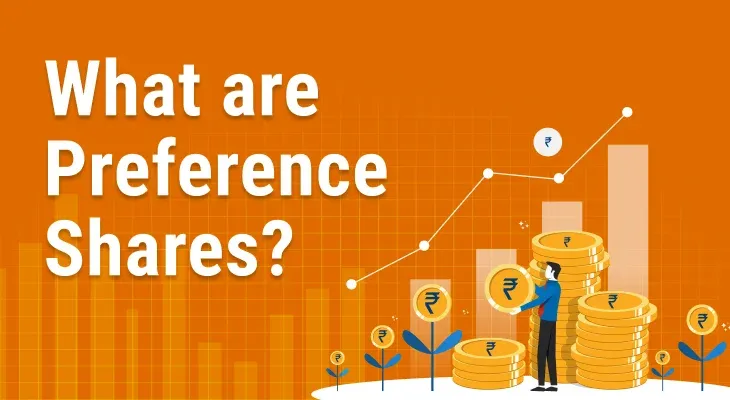
What are Preference Shares?
Equity shares aren't the only type of shares that a company can issue. Sometimes, a company may also choose to issue preference shares, which are fundamentally different from equity shares.
If you’re an investor looking for a passive source of income, you can consider investing in these shares. However, before you do so, here’s everything you need to know about preference shares.
What are Preference Shares?
Preference shares are a type of shares that feature the characteristics of both equity and debt instruments. These shares offer dividends to holders, just like equity shares. Furthermore, they can be bought back (or redeemed) like debt instruments.
Preference shareholders are entitled to a fixed dividend that the company has to pay if it makes a profit. They rank above equity holders in the order of preference for dividend payment as well. So, if a company decides to issue dividends, it has to pay the preference shareholders first. If there are any profits remaining after the payment of preference share dividends, the company may then choose to distribute it among equity shareholders.
Companies issuing preference shares often do so to attract investors. The promise of fixed dividend payments is more likely to encourage investors to subscribe to these shares than the promise of mere ownership in the company.
Types of Preference Shares
Now that you’re aware of the meaning of preference shares, let’s proceed to take a look at the different types they come in.
Convertible Preference Shares
These shares can be converted to equity shares at a later point in time.
Non-Convertible Preference Shares
Such preference shares cannot be converted to equity shares.
Redeemable Preference Shares
These shares will be redeemed (or bought back) by the company at a set date and price in the future. In India, preference shares must be redeemed within 20 years from the date of issue.
Irredeemable Preference Shares
These shares will not be redeemed by the company. As per the Companies Act, 2013, issuing irredeemable preference shares is prohibited.
Cumulative Preference Shares
Companies may sometimes be unable to pay dividends to preference shareholders due to a lack of profits. In the case of cumulative preference shares, these unpaid dividends continue to accrue year after year. The holders of such shares get the right to receive unpaid dividends in the form of arrears when the company becomes profitable.
Non-Cumulative Preference Shares
Non-cumulative preference shareholders don’t get the right to receive unpaid dividends in the form of arrears. If a company doesn’t pay dividends to such shareholders due to a lack of profits, that year’s dividend payment will go unpaid and cannot be claimed in the future.
Participating Preference Shares
In addition to the fixed dividend, participating preference shareholders are entitled to additional dividends from the surplus profits available after distribution to equity shareholders.
Non-Participating Preference Shares
Non-participating preference shareholders are only entitled to fixed dividends.
Adjustable Preference Shares
These shares feature an adjustable dividend rate. This rate is subject to change from time to time as per the prevailing market rates.
Features of Preference Shares
Preference shares come with several features that make them a very attractive proposition to both companies and investors. Some of the key features of these shares have been briefly elaborated below.
Dividend Payments
Preference shareholders are entitled to dividends at a fixed rate set by the company. If a company makes a profit, holders of these shares are guaranteed to get paid at the specified rate.
Preference During Liquidation
When a company is liquidated, preference shareholders get preferential treatment. Their dues are paid off before those of equity shareholders.
Convertible Nature
Preference shares can be converted into equity shares by the company. The date and the ratio of conversion are usually notified at the time of issue of the shares itself.
Voting Rights
Unlike equity shareholders who get voting rights, preference shareholders don’t get any say in the affairs of the company. That said, the company may choose to give preference shareholders the right to vote on certain resolutions.
Why Should You Consider Investing in Preference Shares?
There are some key reasons to consider investing in preference shares. Firstly, as the holder of such shares, you get a passive source of income in the form of dividends whenever the company makes profits.
Secondly, depending on the type of preference shares that you invested in, they will either be converted to equity or redeemed by the company. In the case of equity conversion, you stand to benefit from capital appreciation, whereas, in the case of redemption, you get back your initial investment.
And finally, if the company were to get liquidated, you will be given preference over equity shareholders. The funds from liquidation will be used to clear your dues before the company moves on to settle the liabilities towards equity holders.
What are the Risks Associated with these Preference Shares?
Although preference shares offer a lot of advantages, they do come with a few risks. Preference shareholders are entitled to dividends only if the company makes a profit. If it doesn’t, they may not receive any earnings. Also, in the case of adjustable preference shares, there’s a lot of uncertainty surrounding the dividend that you’re entitled to receive.
Conclusion
Although issuing preference shares can be advantageous for the company, it can be expensive to issue these securities owing to the guaranteed dividend on them. That’s primarily why these shares are usually only offered by financially stable companies, which have significant market capitalisations. As an investor, you may consider investing in preference shares if the company issuing it has a strong track record of generating profits.


